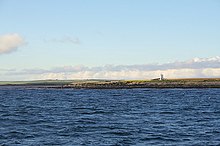Papa Stronsay
| Norse name | Papey Minni/Papey In Litla |
|---|---|
| Meaning of name | Island of the papar near Stronsay |
 Papa Stronsay from the air. The monastery can be seen at the top right. |
|
| Location | |
|
Papa Stronsay shown within Orkney
|
|
| OS grid reference | HY666293 |
| Coordinates | 59°09′N 2°35′W / 59.15°N 2.58°W |
| Physical geography | |
| Island group | Orkney |
| Area | 74 hectares (0.29 sq mi) |
| Area rank | 169 |
| Highest elevation | 13 metres (43 ft) |
| Administration | |
| Sovereign state | United Kingdom |
| Country | Scotland |
| Council area | Orkney Islands |
| Demographics | |
| Population | 0 |
| References | |

The Light on Papa Stronsay.
|
|
|
orkney
|
|
| Location | Papa Stronsay Orkney Scotland United Kingdom |
|---|---|
| Coordinates | 59°09′21″N 2°34′54″W / 59.155837°N 2.581717°W |
| Year first constructed | 1907 (first) |
| Year first lit | 2002 (current) |
| Automated | 2002 |
| Deactivated | 2002 (first) |
| Foundation | reinforced concrete |
| Construction | metal skeletal tower |
| Tower shape | square parallelepiped tower covered by aluminium panels with balcony and light on the top |
| Markings / pattern | white tower |
| Height | 5 metres (16 ft) |
| Focal height | 8 metres (26 ft) |
| Light source | solar power |
| Characteristic | Iso W 4s. |
| Admiralty number | A3706 |
| NGA number | 3268 |
| ARLHS number | SCO-167 |
| Managing agent | Northern Lighthouse Board |
Papa Stronsay (Old Norse: Papey Minni) is a small island in Orkney, Scotland, lying north east of Stronsay. It is 74 hectares (0.29 sq mi) in size, and 13 metres (43 ft) at its highest point.
According to folklore, some of the natives were descended from a female selkie. This was because they had horny skin on their feet and hands, and permanently smelt of fish.
The geology is middle old red sandstone.
A thin tongue of land curls west from the main part of the island, and then south to form the Point of the Graand (a local word meaning a "sandbar"). The island in general is low lying, reaching a mere 13 metres (43 ft) at its highest point.
There is an 8 metres (26 ft) high light beacon in the north east.
The island has remains of two chapels. One dates from the eleventh century, and an eighth-century Pictish monastery may lie under it. It has been described as the most northerly early Christian monastery ever found. Other remains include cairns and a Burnt mound, and a number of abandoned crofts.
The island is one of the "Papey"s or "islands of the papar. Joseph Anderson noted that:
The Orkneyinga saga recalls in Chapter XXXIV that Earl Rögnvald was killed on Papa Stronsay in 1046:
Everyone agrees that of all the Earls of Orkney Rögnvald Brusason was the most popular and gifted, and his death was mourned by many (Orkneyinga saga Ch. XXIX).
Earl's Knowle on Papa Stronsay is traditionally thought to be the final resting place of Sir Patrick Spens. The history relating to the burial of Sir Patrick Spens on Earl’s Knowle on Papa Stronsay is related by William Edmonstoune Aytoun (b. Edinburgh 21 June 1813, d. 4 August 1865). He was made Sheriff and Lord Admiral of Orkney and Shetland in 1852. It was after his retirement from this position that he edited a collection of Scottish poetry in which the first poem is Sir Patrick Spens. In his forward to the poem Aytoun wrote:
...
Wikipedia


